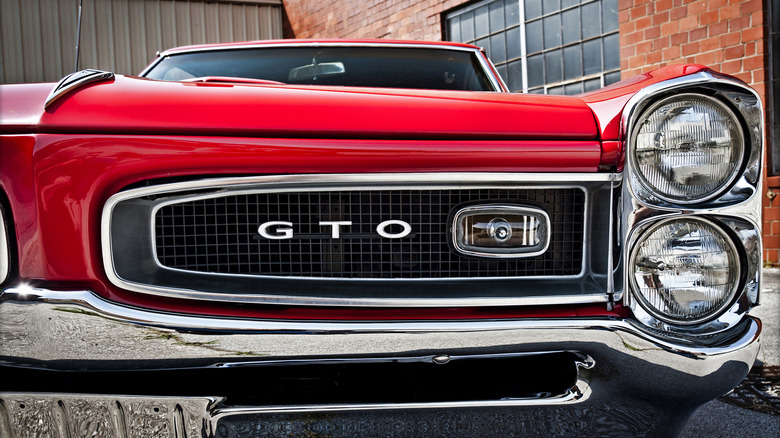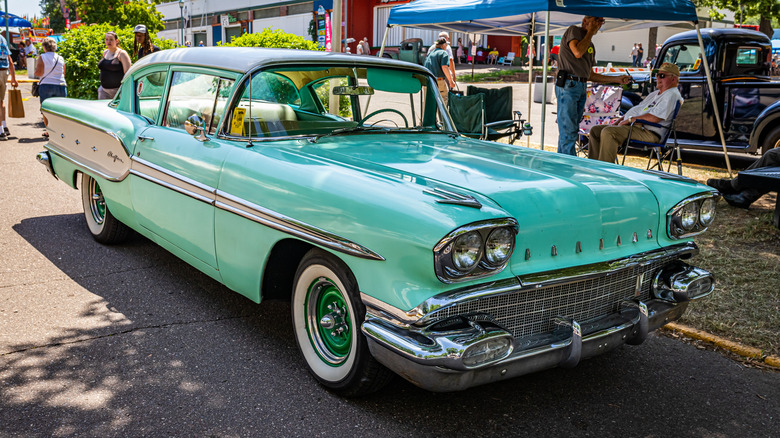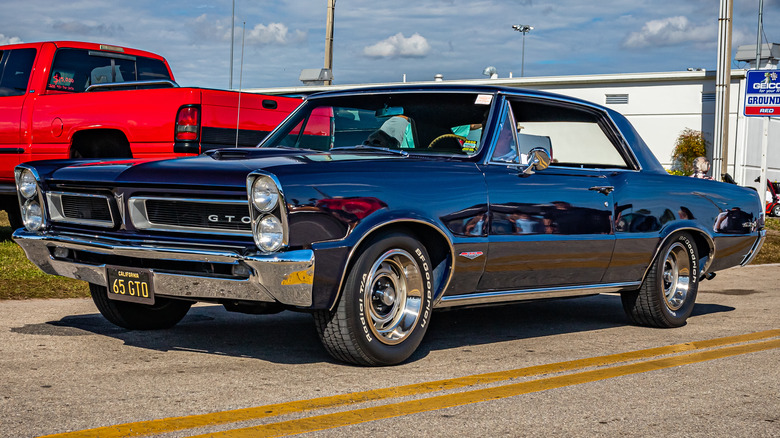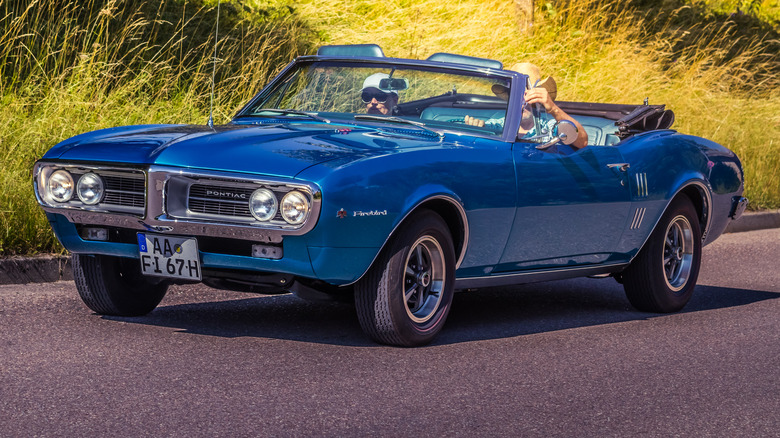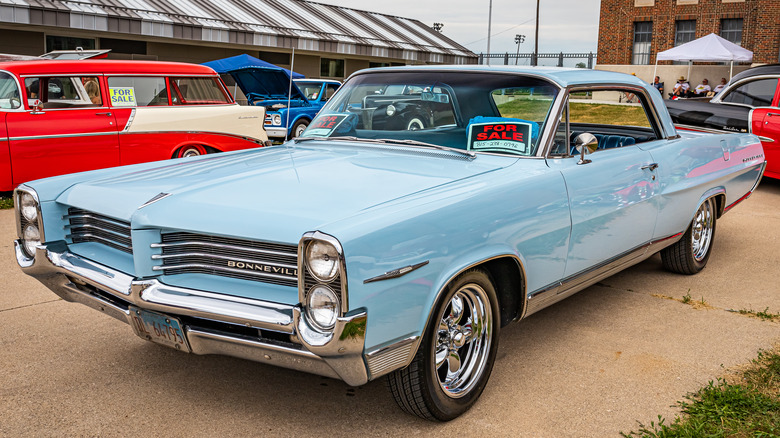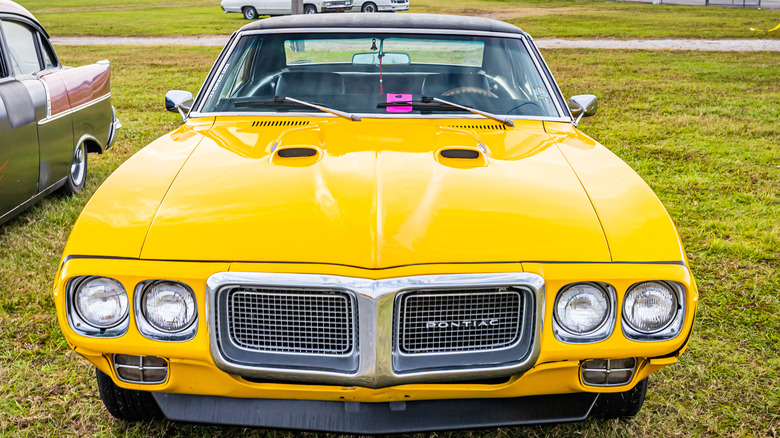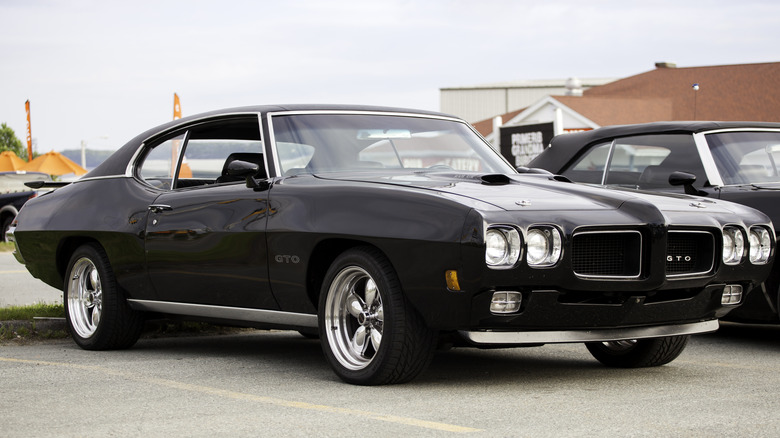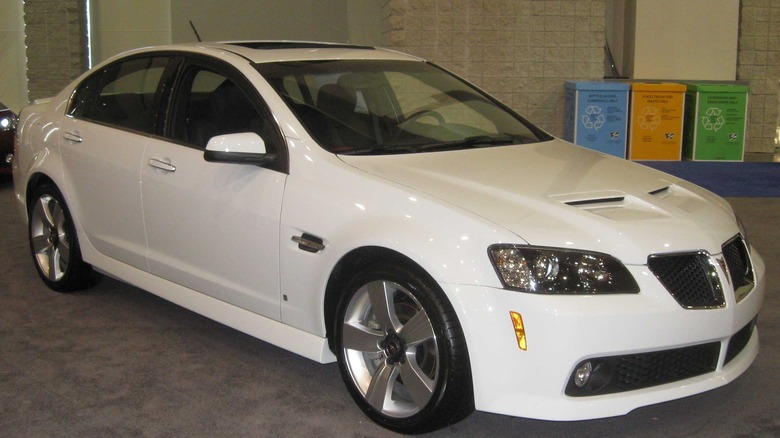8 Of The Best Engines Ever Put In A Pontiac Muscle Car
Despite a tragic demise ushered in by the 2008 financial crisis, Pontiac has a long and storied history in the annals of automobile development. From the racetrack to the streets, famous names like the Firebird, GTO, Grand Prix, and Tempest, as well as several other underappreciated Pontiac muscle cars, have been stuffed with V8 engines and pushed into the market.
The inaugural Pontiac V8, a 251 cubic-inch flathead introduced in 1932, was an 85-horsepower parts bin special that lasted a single year. Afterward, Pontiac returned to straight six- and eight-cylinder engines for another decade and a half. It wasn't until 1955, when they retooled their brand to appeal to youthful buyers, that Pontiac landed on a functional 287 cubic-inch V8, the forebear of the powerplant for some of the most iconic muscle cars ever.
Pontiac had some of the coolest-looking cars, but it was the company's powerplants that developed a committed fan base. Not all engines are created equal. Personal preference and usage dictate a lot of what makes a great motor, but Pontiac made some of the most iconic cars of its time. Join us as we take a look at the legacy, development, performance, and cool factor of some of the best engines ever put in a Pontiac muscle car.
Tempest 395-A 370
After nailing down their V8 game with the 287, Pontiac made a habit of boring their motors ever bigger, ultimately reaching gargantuan heights that would even outdo Chevrolet's biggest offering by a mere cubic inch (got you last!). It took a mere three years for Pontiac engineers to develop their 287 up to 370 cubic inches, resulting in the confusingly named Tempest 395-A.
Muscle car enthusiasts might recognize that moniker, but don't get confused. The Pontiac Tempest never had a Tempest 395, and the name did not reflect the displacement. However, it was a start — the first step down a path that would lead to muscle car greatness.
Oozing old-school '50s style, the 1958 Pontiac Chieftain is very clearly a dad car unlikely to appeal to the youth. But the Tempest 395-A under the hood delivered up to 330 horsepower — an insane power rating by the standards of the day. The Tempest engine never made it into the muscle cars of the mid-to-late 1960s, but it definitely carved the path for them.
The 389
By 1960, American car companies were on the verge of a displacement race. More combustion meant more power, and the only way was up. Pontiac increased the bore of the Tempest-A to achieve an additional 19 cubic inches of displacement, branding the new engine the 389.
With a production run from 1959 to 1966, the 389 oversaw Pontiac's transition from a family car manufacturer to a full-fledged combatant in the muscle car wars. Not every car that got the 389 was a performance edition. The Catalina, Venture, Star Chief, and Bonneville all came with the engine, but the real star proved to be one of the most iconic muscle cars of all time: the Pontiac GTO.
The Pontiac Tempest (the car, not the engine) had become one of the mainstays of the performance market, but when a builder named Mickey Thompson slammed a 389 under the hood, he ignited a fire in the populace for lightweight cars with monster engines. By 1964, this formula needed its own name badge, and the legendary Pontiac 1964 GTO was born. The 389 was not the only engine offered in the GTO, but those with the 389's trio of double-barreled carbs, more famously known as Pontiac Tri-Power, commanded up to 345 horsepower in the years before Pontiac phased the engine out.
The 326
A new V8 landed in 1963, and it didn't increase displacement for a change. Advertised as the 326, this engine nonetheless had a displacement of 336 cubic inches in its first year. Pontiac had decided to spin the LeMans off into its own nameplate, and the Y-body Tempest and Lemans needed a smaller engine to handle the job. Cutting the 389 down by decreasing the bore, the two-barrel carburetor configuration provided a respectable 250 horsepower, while the four-barrel high output option put up closer to 280 horsepower. The engine looked much like the 389, but smaller pistons and a light crankshaft joined the reduced bore as changes that made it suitable for the job.
The oddball configuration makes the 1963 LeMans a rare and sought-after model. Later, the 326 enjoyed a career as the inaugural base engine for the Pontiac Firebird's debut, this time actually displacing 326 cubic inches and supplying 250 horsepower. That might not seem like a ton by today's standards, but it was enough to get muscle car fans drooling over the debut Firebird.
The 421
Arriving the same year as the 389, Pontiac's 421 cubic-inch V8 became a factory option in 1962. Debuting late in the year as a larger version of the 389, the 421 sported increased displacement via a 4.09-inch bore and internal improvements like forged-steel piston rods, aluminum pistons, and a flat-tappet crankshaft.
After installing the engine into the 1962 Catalina, Pontiac officially met homologation standards, which made it eligible to take the 421 racing. And race it did; driver Joe Weatherly took the Nascar Grand National Championship for Pontiac that year, winning nine races and scoring 31 podiums. The hoods of the NASCAR racers proudly displayed the 421 cubic inch 405 horsepower designation, so everyone knew the 421 Super Duty (SD) propelled these cars to such impressive victories.
Though the Catalina, Bonneville, and Grand Prix models that sported the 421 don't usually come up in the conversation of classic muscle cars, their race pedigree and representation of a step in the evolutionary chain from the late 1950s to the muscle cars of the mid-1960s places them squarely in the pantheon of beefy Pontiac winners that cleaned up NASCAR and paved the way for future greats.
The 400
Some of the engines on this list represent portions of the development history that led to the golden years of the muscle era, but any Pontiac or muscle car fan could tell you about the 400 cubic-inch Firebird mill.
Pontiac's 400 cubic-inch engine was the workhouse motor of the muscle car's glory days. It was a well-rounded engine appreciated by amateur and professional mechanics alike and received many upgrades and much aftermarket attention. In true Pontiac tradition, engineers bored out the 389 to gain a further 11 cubic inches of displacement. Its 1967 debut positioned it perfectly for the new Firebird, not to mention late-60s GTOs and Pontiac's hidden gem, the Can-Am.
The original Firebird came with a 326, but gearheads could opt for the 400 or the 400 Ram Air options, pushing horsepower into the 360 range. For a big-block gas guzzler, the 400 proved surprisingly versatile, outlasting many of its contemporaries into the regulatory area, not ceasing production until 1978.
The 455
The bored and stroked version of the 400 arrived in 1970 at the height of the muscle car era. It was not super competitive with the high-performance engines of the other big companies, but it produced vast amounts of torque and had enormous potential for tuners.
MOPAR had the 440, Chevrolet the 454, and Ford the 427, but Pontiac outdid them all, topping incestuous competitor Chevy by a single cubic inch. The Pontiac 455 hit the scene in 1970, perhaps the high-water mark of muscle car production, and nearly missed the party entirely. The Clean Air Act of 1970 and rising gas prices took their toll. The market wanted more fuel-efficient cars, and "big-block gas-sipper" is a contradiction of terms.
Fortunately, Pontiac ignored the last call, serving up the 455 in 1970 as a 370 horsepower, 500 ft-lb torque monster that had to be toned down almost as soon as it revved up. Still, the 455 did its duty, powering the GTO in a de-fanged H.O. version until 1972 and living on in the Firebird until 1976.
The 5.7 liter
By the early 1990s, the muscle car era was a twinkle in the memories of a generation of aging gearheads. Environmental standards, geo-political crises, and governmental regulation had long since gutted the big displacement, big power days of the 1960s and 1970s. But a few cars still carried the torch.
We find the fourth-generation Pontiac Firebird in that strange middle ground between too recent to be cool and too common to be sought after. Produced between 1993 and 2002, the fourth-gen phoenix is low on the list of must-have muscle, but perceptions can be deceiving. The Firebird's last gasp produced respectable power numbers. Under the hood of the high-performance Trans Am option, a new generation of muscle fans could find a 5.7-liter LT1 V8.
The days of independently engineering powerplants by brand were long gone, and Pontiac had to rely on parent company General Motors for its engines. Regardless, the LT1 was no slouch. In 1993, it put down a solid 275 horsepower. By the final iteration of the Firebird in 2002, that number had crept up to 310. Available with a six-speed transmission and the coolest of all roof configurations, the T-top, these last Firebirds are often overlooked. Could it be a sleeper pick for a future classic?
The LS3
There is no question that the fifth-generation S197 Ford Mustang reignited a passion for the muscle of bygone days. The Firebird and Camaro ended in 2002, and decades had passed since the death of the GTO, Chevelle, Barracuda, and others. The wild popularity of Ford's retro design and decades of technological development that could produce powerful V8 engines within environmental parameters spawned a resurgence in muscle car nameplates. Before long, the Camaro, Challenger, and Charger rejoined Ford in the fray, with varying success.
By 2008, Pontiac's days were numbered, but it had one last trick up its sleeve. In its final production year, Pontiac released the Pontiac G8 GXP. Combining styling influenced by the Australian Holden Commodore with a 6.2-liter LS3, the GXP might be called Pontiac's last muscle car.
The GXP put more than 400 horsepower to the ground. Its plain styling didn't have the old-school charm of the retro Mustangs and Camaros, but for Pontiac fanatics, it was the last tip of the cap from a legendary manufacturer riding into the sunset.
